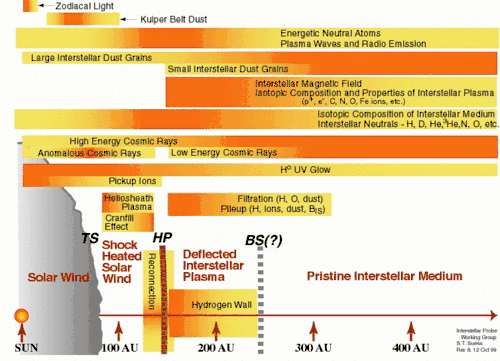Interstellar Probe (1999)
Interstellar Probe is the name of a 1999 space probe concept by NASA intended to travel out 200 AU in 15 years.[1] This 1999 study by Jet Propulsion Laboratory (JPL) is noted for its circular 400 meters diameter, solar sail as a propulsion method (1 g/m2) combined with a 0.25 AU flyby of the Sun to achieve higher solar light pressure, after which the sail is jettisoned at 5 AU distance from the Sun.[2]
 Concept art for the proposed spacecraft, backdropped by stars | |
| Operator | NASA |
|---|---|
| Applications | To travel out 200 AU in 15 years |
| Specifications | |
| Spacecraft type | Space probe |
| Power | Solar sail |
| Dimensions | |
| Diameter | 400m |
Solar sail
Solar sails work by converting the energy in light into a momentum on the spacecraft, thus propelling the spacecraft.[3] Felix Tisserand noted the effect of light pressure on comet tails in the 1800s.[3]
The study by the NASA Jet Propulsion Laboratory, proposed using a solar sail to accelerate a spacecraft to reach the interstellar medium. It was planned to reach as far as 200 AU within 10 years at a speed of 14 AU/year (about 70 km/s, and function up to 400+ AU.[1] A critical technology for the mission is a large 1 g/m2 solar sail.[1]
Interstellar Probe, 1999[4]
In the following years there were additional studies, including the Innovative Interstellar Explorer (published 2003), which focused on a design using RTGs powering an ion engine rather than a solar sail. Another project in this field for advanced spaceflight during this period was the Breakthrough Propulsion Physics Program which ran from 1996 through 2002.
Later examples of solar sail-propelled spacecraft include IKAROS, Nanosail-D2, and LightSail.[5] Near-Earth Asteroid Scout is a planned light sail-propelled mission.[6] For comparison, the LightSail spacecraft uses a sail 5 micron in thickness, whereas they predict a sail with 1 micron thickness would be needed for interstellar travel.[3]
Other design features
The probe would use an advanced radioisotope thermoelectric generator (RTG) for electrical power, Ka band radio for communication with Earth, a Delta 2 rocket for Earth launch, and a 25 kg instrument package using 20 watts.[1]
Objectives
Historical view of region
See also
- Breakthrough Starshot, a fleet of small light sail spacecraft
- Innovative Interstellar Explorer
- Interstellar probe (generic)
- TAU (spacecraft) (1980s era interstellar precursor and astrometry probe)
- Stardust (spacecraft) (Believed to have collected some interstellar micro-dust)
- Interstellar Boundary Explorer (Space observatory that detects neutral atoms from beyond)
- Magsail
References
- "Interstellar Probe". Interstellar.jpl.nasa.gov. Archived from the original on 2009-07-31. Retrieved 2015-10-09.
- "4 An Interstellar Probe to the Boundaries of the Heliosphere and Nearby Interstellar Space - Exploration of the Outer Heliosphere and the Local Interstellar Medium: A Workshop Report - The National Academies Press". doi:10.17226/11135.
- "Propelled by light: the promise and perils of solar sailing".
- "NASA IP".
- "LightSail Space Mission Will Shine Global Spotlight on Solar Sails".
- "NEA-Scout". space.skyrocket.de.

